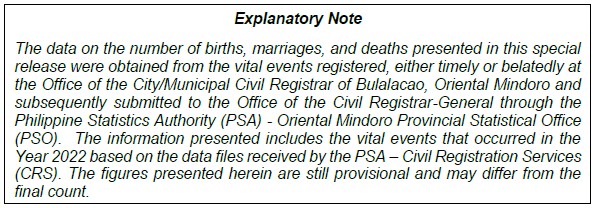
Birth Statistics
The Municipality of Bulalacao was able to register 501 births in 2022, equivalent to an increase of 29.8 percent compared to registered births in 2021 with 386 births. Moreover, more females (253 or 50.5 percent share) were born than males (248 or 49.5 percent share), resulting in 98 males per 100 females sex ratio at birth. (Figure 1)
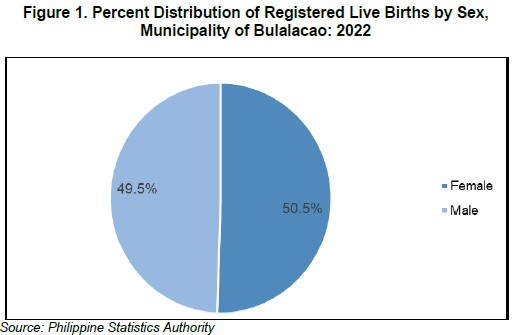
Of the recorded 501 births, there is more timely registration of births (384 births or 76.6 percent share) compared to late registration (117 births or 23.4 percent share).
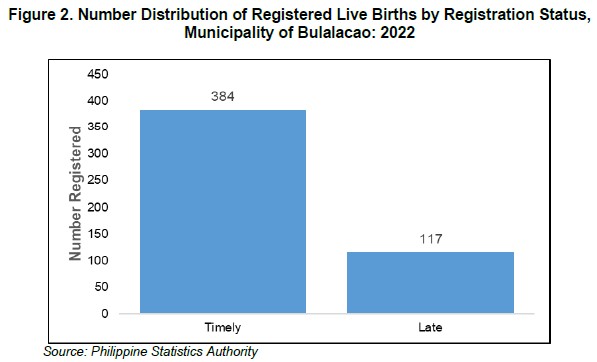
November had the greatest number of registered births with 63 births or 12.6 percent of all registered births. The months of October with 12.0 percent and January with 9.6 percent) came next. September, on the other hand, had the lowest percentage of births at 3.8 percent.
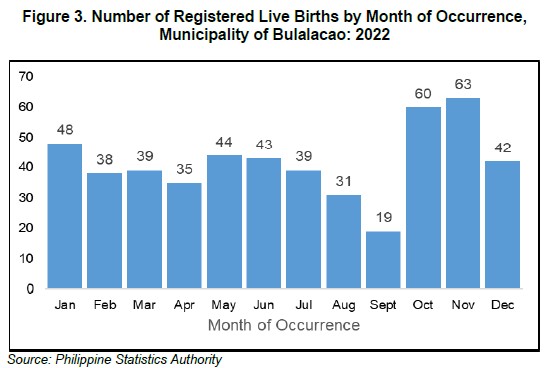
Of the total number of births in Municipality of Bulalacao, 51.7 percent were attended by hilot/traditional birth attendant. On the other hand, 47.3 percent of births were delivered by a physician.
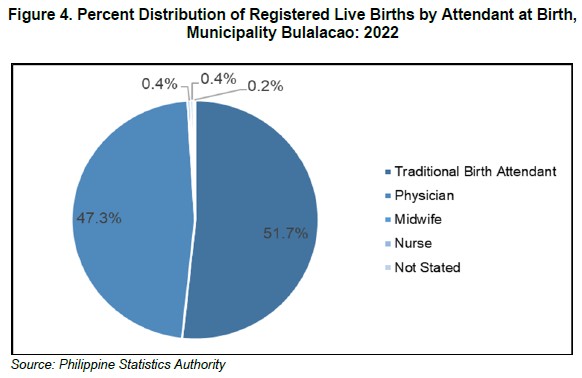
In 2022, a higher percentage of births with 52.7 percent took place in at home, this was a slight higher on births that occurred in a health facility. A health institution, such as a hospital, birthing clinic, lying-in, outpatient care center, specialized care center, or the like, was used to deliver just 47.3 percent of newborns.
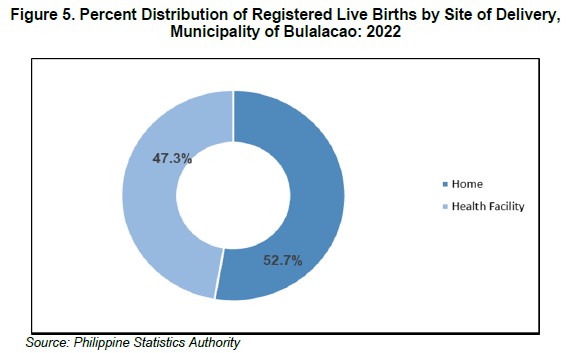
Mothers between the ages of 20 to 24 accounted for 137 births or 27.3 percent of all births registered in the Municipality of Bulalacao. Furthermore, of the 136 births in the town, or 27.1 percent of all births, were from the ages of 25-29 years old. (Figure 6)
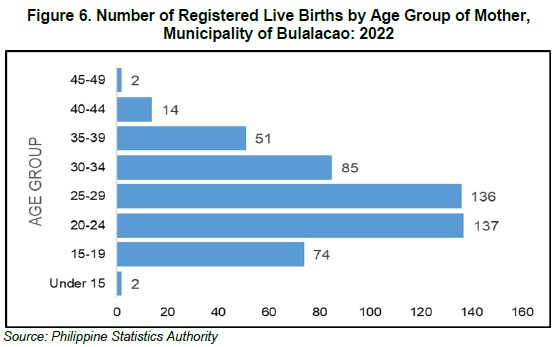
Most registered births were nonmarital children with 280 births or 55.9 percent of the total births in Municipality of Bulalacao. On the other hand, marital children registered 221 births or 44.1 percent of total births registered, lesser than that of nonmarital children. (Figure 7)
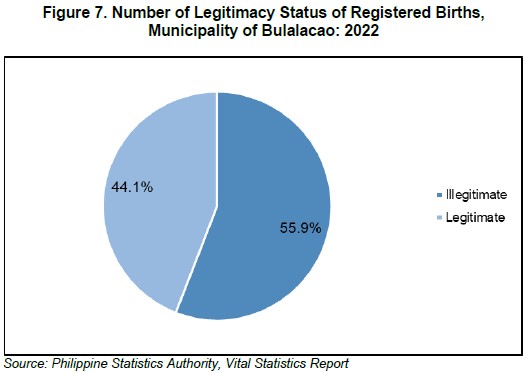
Marriage Statistics
In 2022, a total of 590 marriages were registered, an increase of 413. 0 percent from the total registered marriages of 115 in 2021. Comparing with the number before the pandemic, an increase of 73.0 percent was observed from 2019 to 2022. (Figure 8)
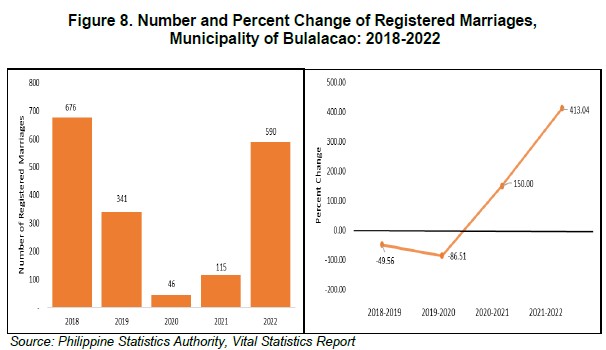
The month May recorded the highest number of registered marriages with 489 or 82.9 percent share of the total marriages in Municipality of Bulalacao. The month of December ranked second with 25 marriages or 4.2 percent share, followed by the months of March and April with 14 marriages or 2.4 percent share, each. On the other hand, the months of August and November had the least number of registered marriages with one marriage or 0.2 percent share, each. (Figure 9)
Of the total registered marriages in 2022, 86.3 percent or 509 unions, were conducted in civil ceremonies. In contrast, only 7.6 percent of the total marriages, representing 45 couples, chose to have their ceremonies officiated in Roman Catholic churches. Additionally, 6.1 percent, which corresponds to 36 marriages, were celebrated through various other religious rites. (Figure 10)
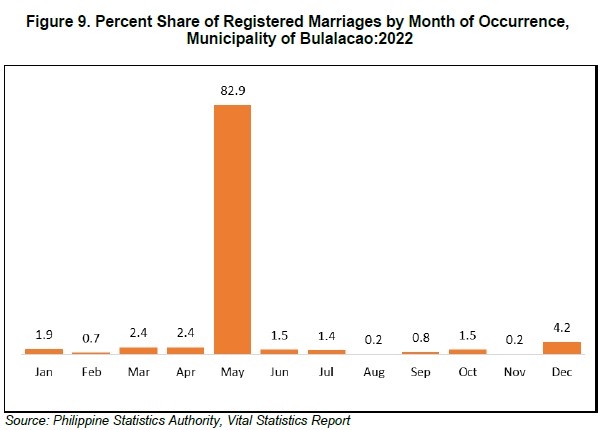
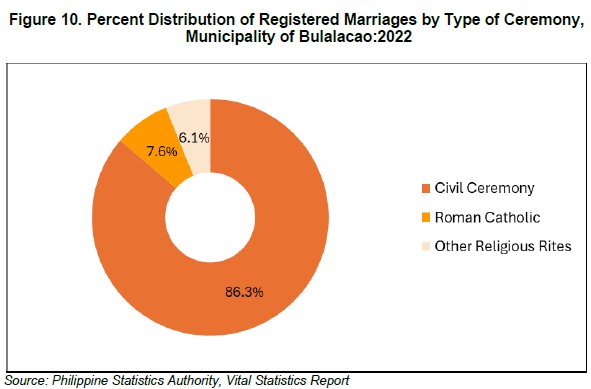
The majority of the couples in Municipality of Bulalacao married between ages 25-29 years. Approximately 174 men (or 29.5 percent) and 161 women (or 27.2 percent) married within this age range, making it the most common age for marriage among both genders.
Additionally, women are more likely to marry at a younger age than men. A total of 54 marriages, or 9.2 percent, involved adolescent females aged 15-19, compared to just nine marriages, or 1.5 percent, for adolescent males in the same age group.
(Figure 11)
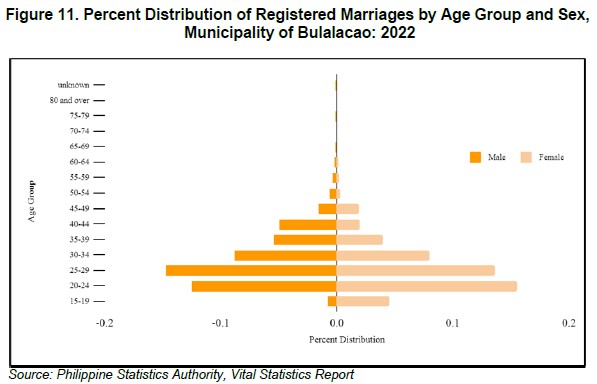
Death Statistics
The municipality of Bulalacao was able to record 193 deaths for the year 2022, translated to the average 16 deaths per month. Month of March had the highest registration of deaths in 2022 with 24 deaths, followed by the month of April with 21 deaths, then followed by the month of August with 20 registered deaths. Month of February had the least number of registered deaths with only 10. (Figure 12)
Of the 193 deaths in the municipality of Bulalacao in 2022, there were 110 male deaths (57.0 percent) and 83 female deaths (43.0 percent).
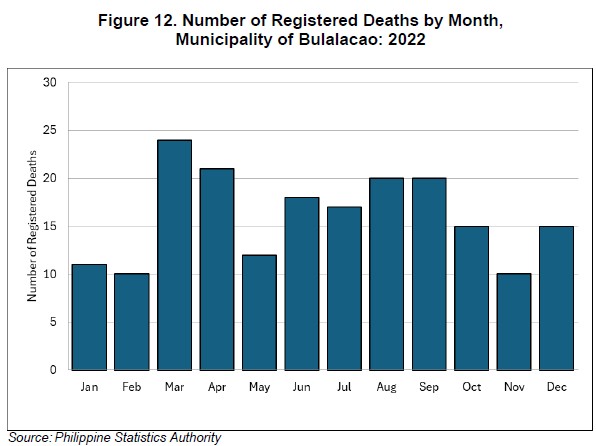
The top three causes of death in the municipality of Bulalacao from January to December 2022 were Intracerebral haemorrhage, Acute myocardial infarction, and Respiratory tuberculosis, not confirmed bacteriologically or histologically and Stroke, not specified as haemorrhage or infarction.
Intracerebral haemorrhage, the top leading cause of death in Bulalacao, took 26 lives or 13.5 percent share of the total deaths in the municipality. On the other hand, Acute myocardial infarction, came in second with 12 deaths or 6.2 percent share of all the total deaths in the municipality. Further, Respiratory tuberculosis, not confirmed bacteriologically or histologically and Stroke, not specified as haemorrhage or infarction were the third leading causes which accounted for 10 deaths, each.
On the other hand, Intracerebral haemorrhage, also is the leading cause of deaths in males, registering 16 deaths or 14.5 percent share of male deaths. Followed by Respiratory tuberculosis, not confirmed bacteriologically or histologically with nine deaths, and Acute myocardial infarction with eight deaths.
Additionally, Intracerebral haemorrhage, also is the leading cause of deaths in females, recording ten deaths or 12.0 percent share of female deaths. Followed by Stroke, not specified as haemorrhage or infarction with six deaths, and Acute myocardial infarction and Unspecified diabetes melllitus with four deaths, each. Out of the 193 registered deaths in the municipality, 103 deaths or 53.4 percent were not attended by any of the private physician or public health officer or hospital authority. Of the 103 deceased individuals with no attendant at death, 59 were males and 44 were females.
Moreover, a total of 55 registered deaths were attended by hospital authorities. Of this, 34 were male deaths and 21 were female deaths, respectively.
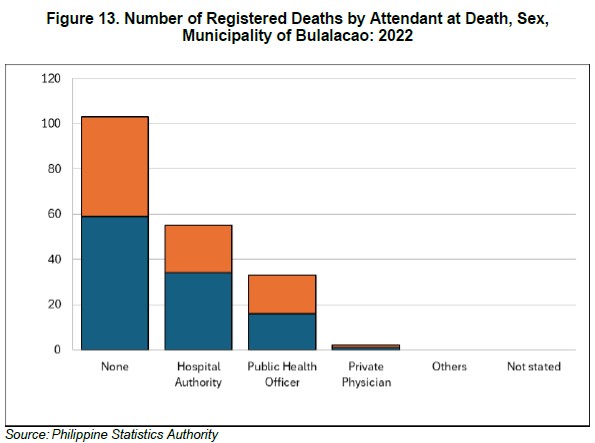
In the municipality of Bulalacao, 133 registered deaths or 68.9 percent occurred at home, from these, 74 deaths were males (55.6 percent) and 59 deaths were females (44.4 percent). Moreover, there were 59 deaths or 30.6 percent occurred at the hospitals, wherein 36 deaths were males (61.0 percent) and 23 deaths were females (39.0 percent). (Figure 14)

(SGD) CHARLYN ROMERO-CANTOS, PhD
(Chief Administrative Officer)
Officer-in-Charge
Oriental Mindoro Provincial Statistical Office
TECHNICAL NOTES ON VITAL STATISTICS
INTRODUCTION
Vital statistics are derived from information obtained at the time when the occurrences of vital events and their characteristics are inscribed in a civil register.
Vital acts and events are the births, deaths, fetal deaths, marriages, and all such events that have something to do with an individual's entrance and departure from life together with the changes in civil status that may occur to a person during his lifetime. Recording of these events in the civil register is known as vital or civil registration and the resulting documents are called vital records.
STRUCTURE OF VITAL STATISTICS SYSTEM
The production of vital statistics comprised of a system of operations in which the registration of vital events is an important component. The system begins with the registration followed by the processing and controlling of vital records and ends with the compilation and analysis of vital statistics.
Under Commonwealth Act (CA) 591, the Bureau of Census (now Philippine Statistics Authority) is mandated to generate general purpose statistics and to carry out and administer Act No. 3753.
Under the same law, the head of the PSA is also the Civil Registrar General (CRG) who directs and supervises the local civil registration activities in the country. The CRG in this regard is empowered to prepare and issue implementing rules and regulations on civil registration and to prepare and order printed the necessary forms for proper compliance.
The set-up of vital statistics system involves different entities and cuts across different departments and personalities.
For the registration of vital events, the Local Civil Registry Offices (LCROs), which are the registration units in the country and headed by the City/Municipal Civil Registrars (C/MCRs), are under the Local Government Units (LGUs). The hospitals, clinics, rural health units and similar institutions including barangay secretaries, practicing physicians, midwives, nurses, traditional midwives, solemnizing officers from various religious sects and denomination are required to assist in the reporting of vital events for registration at the LCROs. The concerned parents, next of kin, contracting parties, a witness or the person who has full knowledge of the occurrence of the event are also required to report the event, in default of the first mentioned set of informants.
The processing and controlling of vital documents are done at the LCROs and at the PSA Provincial and Central Offices.
The compilation and analysis of vital statistics is taken cared of by the PSA Central Office under the Vital Statistics Division of the Civil Registration and Central Support Office.
THE REGISTRATION METHOD
As mandated in Act 3753, all vital events that marked the entry and departure of a person in his lifetime and the changes in his/her civil status shall be registered. The registration method is defined as the continuous, permanents and compulsory recording of the occurrences and characteristics of vital events, primarily for their value as legal documents and secondary for their usefulness as a source of statistics.
Place where to register the event
As a general rule, the place of registration is the LCRO of the city of municipality where the vital events occur.
Out of town reporting of vital event occurs when the documents presented to the civil registrar of LCRO, which is not the place of occurrence, not for registration but to be forwarded to the civil registrar of LCRO where the event occurred and where it should be registered.
Forms to use
The civil register consists of certificates and the registry book. It also includes the actual copies of the registrable court decisions and the legal instruments concerning the civil status of persons. The certificates are loose-leaf forms in a set of four copies except for the Certificate of Foundling which is in a set of three.
Person who will report the event
The informant is the one who reports the event for registration and who gives information to be recorded in the civil register.
For death occurrences, the report shall be made by the hospital or clinic administrator if the person dies in the hospital or clinic, or by attending physician or by the nearest relative or by any interested party who has knowledge of the occurrence of death. In all cases, the report shall be submitted to the Local Health Officer (LHO) who shall direct and order the C/MCR to enter the death in the civil register.
Period when to report the event
Death or fetal death shall be reported to LHO within forty eight (48) hours from the time of death and the LHO shall direct or cause the registration to the C/MCR not later than thirty (30) days from date of death.
Any report made to the LCROs beyond the reglementary period are considered late and can be entered only in the civil register after the informant complies with the requirements for delayed registration.
Operative Act of Registration
The C/MCR sees to it that appropriate form it used; form is properly and completely filled-up; and proper attachments are submitted. In case, the entries are found incomplete, the C/MCR has to require the person concerned to fill up the document completely or to correct the entries.
When the document is accepted for registration, the date of receipt is recorded in the space provided and the documents received for the day are entered immediately in the appropriate civil registry book, assigning therein the corresponding registry number. After registration entry/entries found erroneous can only be corrected through RA 9048, except sex, nationality, age and status which require court approval.
Distribution of registered documents
Upon registration, the C/MCR distributes the copies accordingly: the first copy to the informant; the second copy to the CRG; the third copy shall be retained by the LCRO; and the fourth copy to the attendant or solemnizing officer, as the case may be. The CRG copy is the source of vital statistics published in this report.
DEFINITION OF TERMS AND CONCEPTS
Significant terminologist and descriptions in the foregoing highlights and tables are defined below. Included are some items found in the certificates and summary measure used in describing the facts of events.
Death refers to the permanent disappearance of all evidence of life at any time after live birth has taken place (postnatal cessation of vital function without capability of resuscitation).
Crude Death Rate (CDR) refers to the number of deaths per 1,000 mid-year population.
Daily Average refers to the arithmetic mean of birth, death or marriage occurrences per day.
Daily Index is the increase/decrease from the overall daily average of event occurrences.
Usual Residence refers to the place where the person habitually or permanently resides.
Place of Occurrence refers to the place where the vital event took place.

